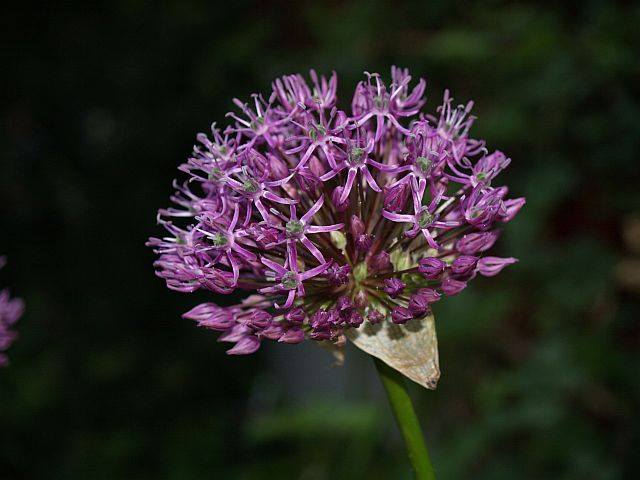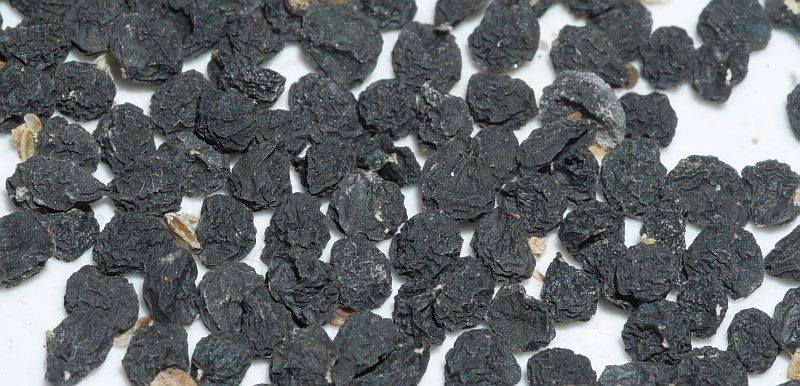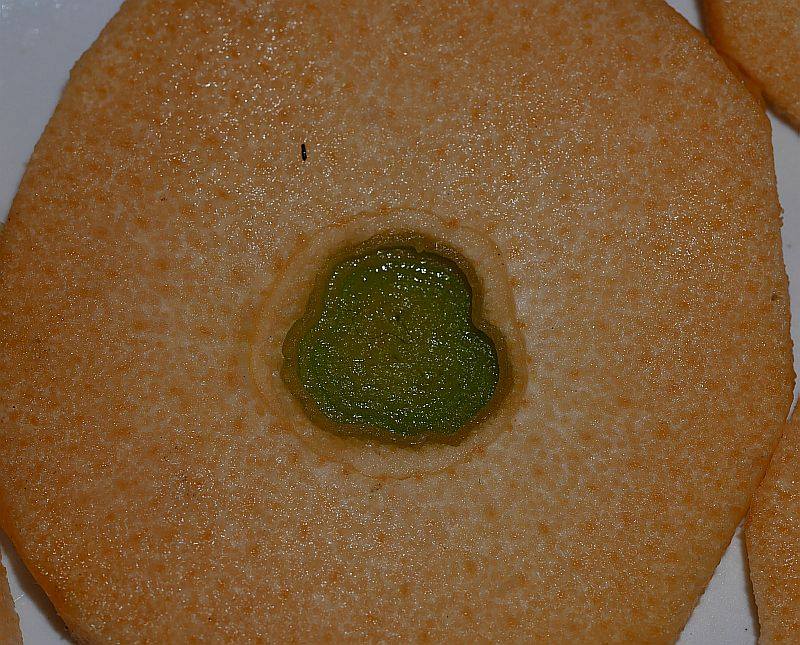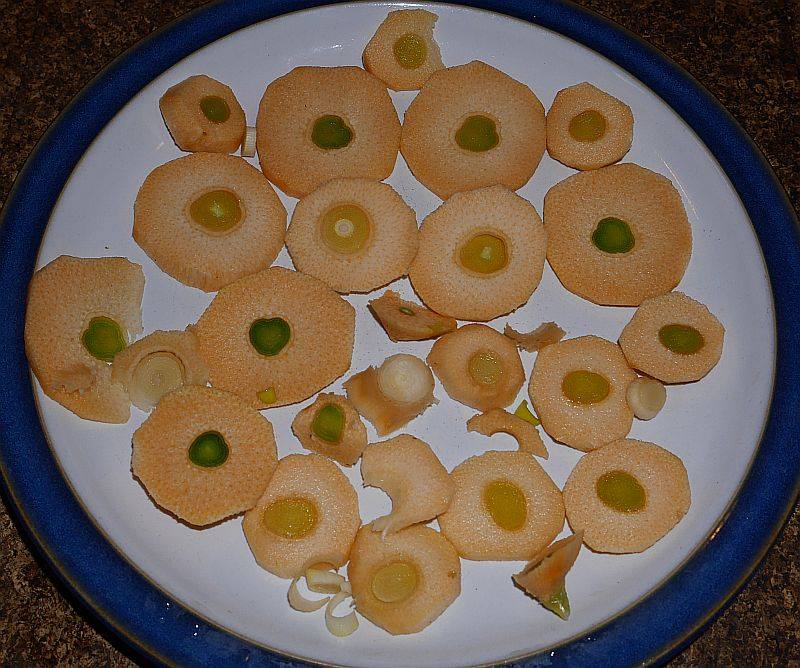I bought my original plant as Allium hirtifolium, a perennial ornamental onion, only later having it identified by my onion friend Wietse Mellema as Allium altissimum, one of at least three botanical species mostly wild collected in West Asia as Persian Shallot (mooseer). Wikipedia: “Most of those eaten are harvested from the wild, sliced, dried, and sold at markets. Buyers will often soak the shallots for a number of days then boil them to obtain a milder flavour. They are often crushed and mixed with yogurt.”
The yield in my garden has been amazing; I’ve given up growing ordinary shallots as the yield is poor…. However, I don’t know yet how quickly these bulbs grow from seed. I’ve therefore collected seed this year…if they grow as quickly as I think they do, this could be one of the best perennial bulb onions for cold climates (and edimental as a bonus)! Here’s an album of pictures of this very tall Allium (altissimum means tallest!). Other species known as Persian Shallot are A. stipitatum and A. hirtifolium.
Today, 28th February 2015, the lovely pink-tipped shoots are appearing:















Where is your snow? I am very excited about this vegetable.
I can only see snow on the mountains and there’s no frost in the ground either in parts of the garden. I prepared a bed and sowed carrots and parsnips earlier on! It’s April, one month early….
Hello I’m very interested in growing Persian shallots stipitatum,do you know where I can purchase them I am in the uk ty
Allium stipitatum is one of the commonly sold bulbs in garden centres in the UK in the autumn. Mount Everest is one cultivar, although have no experience of that one. Google the species and purchase and lots of pages come up. You’ll also find it in RHS Plant Finder!
Persian shallot mostly cultivated in Hamedan , is peerless !very tasty in yoghurt as a side dish with meat and drinks ,dr. Shahram
Thanks for this comment! Do you use the onions dried with the yoghurt or are they rehydrated and cooked first? What’s the name of this dish in Persian?
Do you have any other information (even on Iranian web pages) about how they are cultivated (e.g, from seed or from bulbs?). Do you know a source of the variety which is cultivated. I would be very interested to grow that one in my Allium garden at the botanical garden in Trondheim!
Stephen
I don’t know this still be useful for you or not but here you go ;)
this video shows how to make Yogurt and Persian shallot dip (Mast-o Mooseer) with dried persian shallots but you can make it with fresh persian shallots with the same instructions.
https://www.youtube.com/watch?v=vgn0-V57Eh0
Thanks for the reminder…I made it tonight! See http://www.edimentals.com/blog/?p=21190
What do you think?
I am growing these in London (UK). They are indeed looking very robust and I am hoping for a good crop. When the stalks turn brown and they start to fall in late Summer, that would seem to be harvest time. I’ll eat some fresh and I’ll dry some. Do I harvest only about 25% to allow them to regrow next year as a sort of perennial? I think I read that somewhere? BTW, mine are “Allium Mount Everest” and “Allium Violet Beauty”, both purchased from “J. Parker Dutch Bulbs”. The idea to grow them came from James Wong’s book “Grow for Flavour”.
Cool! You’ll probably find that there is a mix of bulb sizes, so you can just harvest the bigger ones! I haven’t experimented with an optimal harvesting strategy in mind! Let me know how you get on!
I didn’t know that James Wong had written about these. Any chance of a picture or scan of the relevant page(s)?
Stephen, do you know if these work well under deciduous trees? I noticed this year that my ‘Gladiator’ and ‘Mount Everest’ alliums have tasty large leaves that disappeared fast, but I didn’t pay enough attention to them to note when they receded compared to other large leafed spring ephemerals like ramps. I will pay much more attention next year and do some experiments with positioning them when I lift and divide them.
No, I’m afraid not. I’ve never tried them under trees! Let me know how you get on!
Can these be planted in containers on a deck. I live in a townhouse and grow herbs and flowers, but wondering if the cold winters in Pennsylvania will allow for growing Persian shallots.
I’ve no idea, but I think so! There’s only one way to find out. If you can pack around the containers with leaves or similar to protect the plant roots, it would be an advantage.
Hi Stephen, you can’t add a photo in the comments. Here is what James Wong says in his book ‘Grow for flavour’.
“Persian shallots, Allium stipitatum.
This exotic, wild species is gathered from the hillsides of Iran as a gourment delicacy. Tasting like a nutty, aromatic fusion of garlic and shallots, but actually a distinct species from either of the former, these are much prized in Persian cuisine when sliced into salads and chopped into raita-like yogurt dips.
Plant a generous swathe of bulbs in a sunny spot in the autumn to create a spring display that will return for years to come. Once they’re established, you can harvest up to a quarter of the bulbs (they have an intense flavour, so you won’t need that many) each year in autumn to add the exotic warmth of Persia to seasonal dishes. ”
I recommend the book. It is full of great ideas of exceptionally flavourful plants to grow in the UK. And he is a botanist so seems to know what he is talking about.
I haven’t grown persian shallots myself yet but it is on the wish list. Thanks for your blog!
Thanks and sorry for the delay in replying! Yes, somebody else sent me the page from his book! I guess we discovered this fantastic onion independently, although I see I first refer to Persian shallots on FB in 2012 and started growing them in 2007! However, it doesn’t seem that I discovered how good they were as a food plant before my book was published in 2014, the same year that I blogged about them here on edimentals.com, so they are missing from there although the book is mostly about perennial leafy greens. Would defintitely be included as a bonus plant if the publishers agreed to a new edition!
Do you know if some of the large ornamental alliums are Allium altissimum? For example, “Ambassador”. The bulbs are so giant, it would be very satisfying to cook with!
In my Google searches I see there is an A. altissimum ‘Goliath’, but there are many other giant allium varieties that don’t indicate a species name.
Hi again Michalina!
Allium altissimum and stipitatum are interchangeable as food plants in my mind and can be tricky to separate botanically.
According to German Allium expert Reinhard Fritsch (ref 1), Ambassador is Allium stipitatum × A. giganteum (giganteum has also been wild foraged so probably good to eat – I don’t have this one). Fritsch has also written that 60% of Alliums are wrongly identified in the trade and even in botanical gardens in my experience.
Ref 1 also refers to Goliath being closer to stipitatum although the Goliath I’m growing flowers much later that stipitatum/altissimum.
He also believes that the cultivar Venus is alissimum!
Ref 1 https://www.ipk-gatersleben.de/fileadmin/content-ipk/Infrastruktur/Genbank/Allium_Database/150312_OrnamAlliumCheckl_FritschMR.pdf
Oh wow, that checklist is fabulous! Thank you so much for sharing. How do you find these great resources?!
This makes me much more confident to sample some ornamental cultivars (after growing them out for a while to hopefully get rid of any pesticides).
This makes me wonder if there are any allium lookalikes that are poisonous. It sounds like all alliums are edible, but one just needs to be sure of the genus ID? Are there any tricky allium lookalikes that you know of?
PS- I’m really enjoying the plants from our swap! The Dioscorea is doing so well and making bulbils now. Lots of other joys in the garden as well. Thanks again :)
Hello,
I study the history, principles, and practices of Persian cookery and Iranian food.
I am trying to get my hands on a few bulbs of Allium hirtifolium?
Do you by any chance know of sources in the United States or sources that would be willing to ship to US?
With Kind Regards,
Nader Mehravari, PhD (He, Him, His)
Research Associate
College of Agriculture and Environmental Sciences
University of California, Davis
Interesting subject to study :)
Allium hirtifolium is now recognised as a synonym of Allium stipitatum; see https://www.worldfloraonline.org/search?query=allium+hirtifolium
You can learn more about ornamental onions and which species they are from onion specialist Reinhard Fritsch’s paper “Checklist of ornamental Allium species and cultivars currently offered in the trade”
You may also be interested to my use of golpar (Heracleum persicum), a major invasive here in Norway. There are a few recipes for its use in my book Around the World in 80 plants given to me by an Iranian woman here in Norway; see https://www.edimentals.com/blog/?s=golpar
Thank you very much for replying to my question.
I recently purchased ALLIUM STIPITATUM bulbs from this source: https://www.johnscheepers.com/allium-stipitatum-white-giant.html. According to them, ALLIUM STIPITATUM has white flowers.
(These bulbs, that I just purchased, smell exactly like Persian moosir. I cut one open and the interior structure also look exactly like Persian moosir.)
However, the pictures of ALLIUM HIRTIFOLIUM on your webpage (https://www.edimentals.com/blog/?page_id=893) have purple flower.
That is why I thought ALLIUM STIPITATUM and ALLIUM HIRTIFOLIUM are not the same.
After seeing your reply to my note from yesterday, I am now a bit confused!!
Would be kind enough to provide any further clarifications that might help me.
With Kind Regards,
Nader Mehravari, PhD (He, Him, His)
Research Associate
College of Agriculture and Environmental Sciences
University of California, Davis
It was only some time after writing this post that I realised they were synonyms. Alliums in the horticultural trade are often incorrectly identified or hybrids as pointed out by Reinhard Fritsch in the article I referenced. A more detailed treatment of closely related species to stipitatum (there is some variation within the species) with some ethnobotanical information can be found in another paper by Fritsch: “A Preliminary Review of Allium subg. Melanocrommyum in Central Asia”. In the botanical descrition re- flower colour it says: “pale to deep pink to purplish with a purple to greenish median vein darker on the dorsal side”. As in most Alliums white flowered individuals lacking the pigments occur and are often offered in the horticultural trade. So, White Giant is one of the white flowered cultivars, the most commonly garden cultivated variants, although pink-purple is the norm of wild plants!
Ahh.. Thanks much for the additional information. It clears my confusion.
I really want to get my hands on the bulbs of the wild (purple color) cultivar of ALLIUM STIPITATUM .
1. Do you know of any sources?
2. Do you think your onion friend, Wietse Mellema, might have some? If yes, can you share his contact information with me.
Thanks much.
Nader
Nader,
I haven’t bought any but the “variety” ‘Violet Beauty’ (which to me seems like just a trade name of the wild type, but I haven’t looked into it) is Allium stipitatum. There are a number of sources in the US, and A stipitatum is a lot cheaper in purple than white! It’s also available in many of the garden society seed exchanges opening up this month.
According to Allium expert Reinhard Fritsch in his paper “Checklist of ornamental Allium species and cultivars currently offered in the trade”, Violet Beauty is “Allium hollandicum or hybrid of A. cristophii?”
I’m not an allium expert by any means but I agree Violet Beauty does not seem like A. stipitatum even though it is sold as A. stipitatum.
I came across A. stipitatum after I bought a jar of pickled shallots and was confused about why they had a texture like radish and only appeared to have two layers. After some research and stumbling across your blog I decided to grow Mount Everest and Violet Beauty.
After flowering, Mount Everest generally had one large bulb plus two or three small offsets. A few of them split into two medium sized bulbs with a few small offsets. I tried a small bit of one of the offsets raw (but didn’t eat much as I want to increase my stock) and it had a good flavour and tasted just like the pickled shallots. I also got some seed from them which I’m going to sow and see if they grow true to type.
Violet Beauty produced one medium sized bulb plus about five or so offsets which were slightly smaller than the central bulb. The offsets were much bigger than those produced by Mount Everest. The flavour was not nice, either raw or cooked. It had a bitter flavour which left a sort of burning senstation in the back of my throat, and wasn’t very oniony. It didn’t produce any seed, although it may have been because they flowered earlier than Mount Everest so they had insect mesh over them for a lot of the time they were in flower. The flowers looked quite different too, and did look more like A. critophii so it’s definitely plausible that it is an A. hollandicum x A. cristophii hybrid.
Interestingly my new allotment seems to have a bad case of white rot. I lost all of my garlic and lost most of my onions and elephant garlic. Mount Everest was unaffected and only one Violet Beauty showed signs of white rot, so they seem like good alliums to grow.